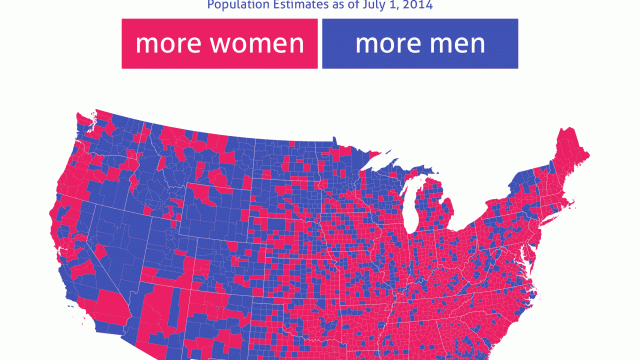Gender Wage Gap? How About The Gender Life Expectancy Gap?

The map above, created from U.S. Census data by Dadaviz’s Jishai Evers, shows which counties in America have more men (blue) and which have more women (pink) and how those populations evolve as the age demographic changes.
As you can see, when we move up in the age demographic women take over the map. Men dominate at younger ages (particularly in western states), but women dominate at older ages. It’s a startling visualization of something that’s fairly common knowledge. Women live longer than men. In fact, women on average live about five years longer than men.
But have you ever wondered why women live longer? Or why that never seems to come up when the debate turns to gender inequality?
To that last point, we are often told that there is rampant sexism in America because of the gender wage gap. Earlier this year North Dakota Senator Heidi Heitkamp posted this tweet to mark Equal Pay Day, supposedly the day in the year representing the amount of time women have to work in addition to men to earn equal pay:
Women in ND make 70 cents 4 every $1 paid 2 men.Will cont. push 4 change during press conference at 11:30amCT. Watch: http://t.co/T9ur4YPKZk
— Sen. Heidi Heitkamp (@SenatorHeitkamp) April 14, 2015
The problem is that Heitkamp and the activists who supplied her with this data are simply comparing the average pay of all full-time working women to all full-time working men without taking into account the different decisions men and women make in their careers.
Like, say, the choice men make to work in far more dangerous careers.
According to the Bureau of Labor Statistics, in 2013 there were 13 men who died on the job for every woman. That same year the incidence rate for non-fatal injuries and illnesses for men was 119.2 per 10,000 full-time workers. For women it was 97.
In North Dakota, specifically, workplace fatalities involving men in 2013 were more than 10 times the number of fatalities for women.
These numbers don’t by themselves explain the gender wage gap, but they explain some of it just as they contribute to the life expectancy gap. Yet the gender wage gap activists don’t want to talk about these numbers.
If women were living, on average, five years fewer than men I suspect some activists would be calling that a national crisis. But men living shorter lives is just accepted as a fact of life, and discarded as irrelevant when talking about the gender wage gap.
Here’s another contributing factor that fewer gender politics activists seem to care about which impacts life expectancy rates: The “silent epidemic” of male suicide.
“Silent,” of course, because it’s not fashionable to talk about things which hurt men men. Particularly white men. According to modern political thinking we’re supposedly privileged in every way a person can be privileged.
Historically, men have a suicide rate that’s about 4 times higher than females according to the American Foundation for Suicide Prevention, and suicide rates are highest by far among caucuasians.
“White males accounted for 70% of all suicides in 2013,” reports the AFSP.
Again, this probably impacting those life expectancy numbers, but who cares right? It’s just privileged white guys offing themselves at rates much higher than any other racial or gender demographic.
The real problem is that women only make 78 cents on the dollar compared to men. Supposedly. Except, that’s not really the case.
“The reality is that for people aged under 40 and working full-time, the gender pay gap is around zero; since 2009 women aged 22 to 29 have actually earned more than men,” writes Joanna Williams, a lecturer at the University of Kent. “Furthermore, evidence shows that as the pay gap falls first for younger people, this smaller differential sticks with each generational cohort as they age. So, if current trends continue, the pay gap should be a thing of the past in the space of some 20 years.”
In other words, the gender wage gap mostly exists because men and women in past generations made different choices about education and career. But now that men and women are making more similar choices, the gap is disappearing and has actually been reversed in younger age demographics.
But the life expectancy gap doesn’t seem to be going anywhere.





